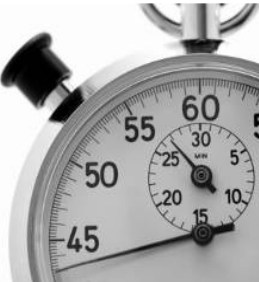System Description
1. Phase 1
In this phase each team must locate a person inside an Area of Interest (AoI). The AoI in a typically AAL scenario could be inside a specific room (bathroom, bedroom, etc), in front of a kitchen etc. The AoI will be disclosed to the competitors before the competition.
Each system is requested to identify 5 Areas of Interest. The actor will move along random paths and will stop in each AoI for 30 seconds.
1.2 Areas of Interest (AoI)
Important note: Please, pay attention about the areas of interest orientation (X and Y axis). Compare each AoI figure with its final location inside CIAmI Living Lab (figure 6) before to extract some conclusions.
AoI 1
Use case: Elderly man is taking a shower (bathroom).
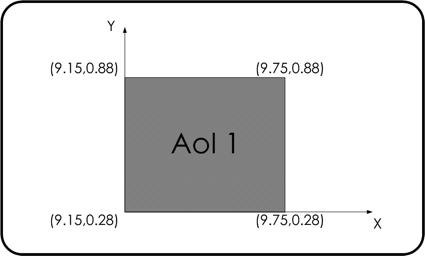
AoI 2
Use case: Elderly man is cooking (kitchen).
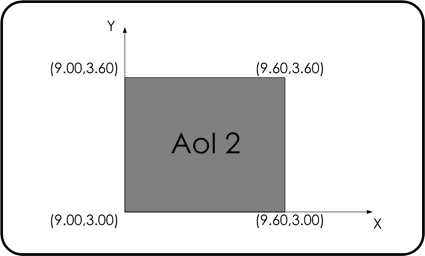
AoI 3
Use case: Elderly man is opening the fridge (kitchen).
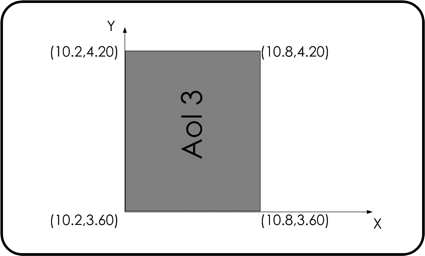
AoI 4
Use case: Elderly man is taking a book from the bookcase (guest room).
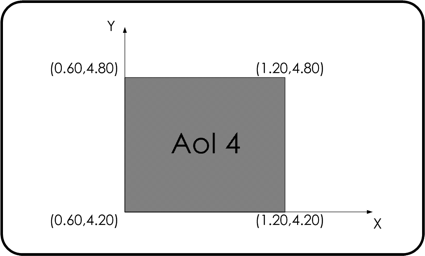
AoI 5
Use case: Elderly man is watching television (living room).
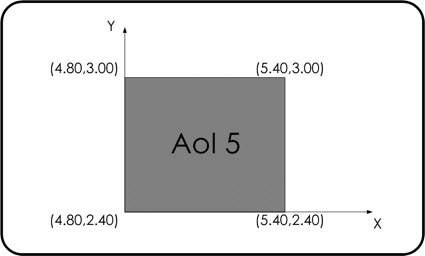
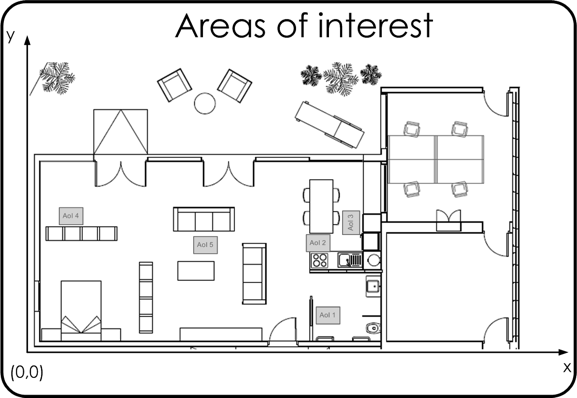
2. Phase 2
In this phase a person that moves inside the Living Lab must be located and tracked (we plan only 2D localization and tracking here). During this phase only the person to be localized will be inside the Living Lab.
In this phase each localization system should produce localization data with a frequency of 1 new item of data every half a second (this will be also used to evaluate availability). The path followed by the person will be the same for each test, and it will not be disclosed to competitors before the application of the benchmarks.
Each system is requested to track the actor along three different paths (the paths are the same for all competitors). The evaluation criteria Accuracy and Availability will be computed on the three paths aggregated. Each path will last up to a couple of minutes. To help the competitors we give a sample path (that will not be used during the competition).
2.1 AAL sample path
- Use case: Aaron is an elderly man (he is 75 years old) who lives with his wife, Sharon, in a very comfortable apartment near to the Valencia´s downtown. Since he was a teenager he has worked as farmer in his father´s lands (they had a lot of lands with Orange fruits and Clementine –a sweet variety of mandarins- cultivated on it). He yearns for those days and for this reason first thing in the morning every day is getting a watering can from his bedroom´s bookcase and going to the garden to water some plants.
- Benchmark:
- EvAAL technician (he) waits in the starting point prior the simulation is launched.
- Sample path is going to the bedroom from the outdoor garden through the guest room.
- The start point is in the bedroom (between bed and a bookcase).
- The stop point is in the garden (outside CIAmI Living Lab).
- EvAAL technician (he) must wait for 6 seconds (6 timer beeps) in the same position (R0 and L0 control points) to simulate the time needed to take a watering can from a bookcase.
- After this, he initiates the walk.
- One step/second is the cadence selected to cover the path.
- The simulation stops when the EvAAL technician arrives to the garden (R12 and L12 control points) and water one plant.
- He must wait 10 seconds (10 timer beeps) in the same position (R12 and L12 control points) to simulate the time employed for an elderly people to water the plants.
- After this the AAL sample scene ends.
- Right and left reference foots (each foot has his own X and Y real coordinates). Where:
- R = right foot at different control points.
- L = left foot at different control points
Action | Foot | X position (m) | Y position (m) |
|---|---|---|---|
Start | R0 | 2.75 | 1.07 |
Start | L0 | 2.59 | 0.89 |
Wait | R0 | 2.75 | 1.07 |
Wait | L0 | 2.59 | 0.89 |
Wait | R0 | 2.75 | 1.07 |
Wait | L0 | 2.59 | 0.89 |
Wait | R0 | 2.75 | 1.07 |
Wait | L0 | 2.59 | 0.89 |
Walk | R1 | 2.84 | 1.33 |
Walk | L1 | 2.58 | 1.5 |
Walk | R2 | 2.85 | 1.8 |
Walk | L2 | 2.58 | 2.02 |
Walk | R3 | 2.86 | 2.31 |
Walk | L3 | 2.6 | 2.51 |
Walk | R4 | 2.9 | 2.8 |
Walk | L4 | 2.63 | 3.0 |
Walk | R5 | 2.94 | 3.34 |
Walk | L5 | 2.69 | 3.52 |
Walk | R6 | 3.0 | 3.84 |
Walk | L6 | 2.75 | 4.09 |
Walk | R7 | 3.05 | 4.39 |
Walk | L7 | 2.8 | 4.66 |
Walk | R8 | 3.1 | 4.92 |
Walk | L8 | 2.85 | 5.16 |
Walk | R9 | 3.2 | 5.4 |
Walk | L9 | 2.93 | 5.65 |
Walk | R10 | 3.26 | 5.94 |
Walk | L10 | 2.94 | 6.21 |
Walk | R11 | 3.23 | 6.45 |
Walk | L11 | 2.96 | 6.7 |
Walk | R12 | 3.26 | 7.02 |
Walk | L12 | 3.12 | 7.03 |
Wait | R12 | 3.26 | 7.02 |
Wait | L12 | 3.12 | 7.03 |
Wait | R12 | 3.26 | 7.02 |
Wait | L12 | 3.12 | 7.03 |
Wait | R12 | 3.26 | 7.02 |
Wait | L12 | 3.12 | 7.03 |
Wait | R12 | 3.26 | 7.02 |
Wait | L12 | 3.12 | 7.03 |
Wait | R12 | 3.26 | 7.02 |
Wait | L12 | 3.12 | 7.03 |
Stop | R12 | 3.26 | 7.02 |
Stop | L12 | 3.12 | 7.03 |
Table 1– Sample path static coordinates
Important note: The sample path is composed by two wait control areas and to cover it is needed 25 steps (13 right and left foots). Please, pay attention that all routes don´t have the same number of wait control areas neither distance
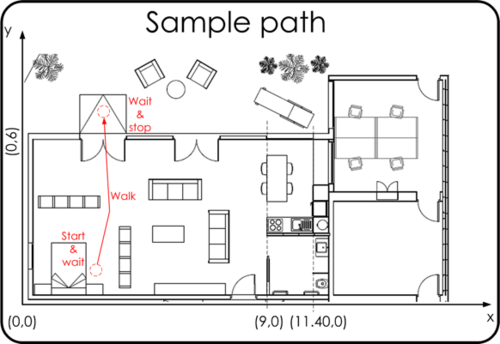
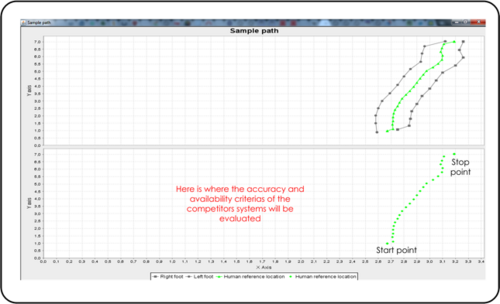
3. Appendix
Some biomechanics definitions connected with the EvAAL competition that could be helpful for competitors.
- Stride length. The stride length is the distance between two successive placements of the same foot, consisting of two step lengths. It depends on:
- The length of the lower limbs.
- The age of the population.
- The human condition.
- Step length. The step length is the distance between two successive placements of the alternates foots, consisting of a half of one stride lengths. It depends on:
- The length of the lower limbs.
- The age of the population.
- The human condition
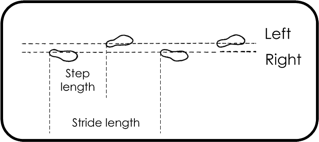
- Cadence. The cadence is the beat or timing of a particular rhythmic activity. For us, the concrete rhythmic activity will be the human movement. This parameter will be measured in steps by minute (step/min) and it depends on:
- The user´s location (the cadence is lower at indoor environments than outdoors).
- The user´s habits.
- The age of the population.
- The human condition.
- Male/female condition.

